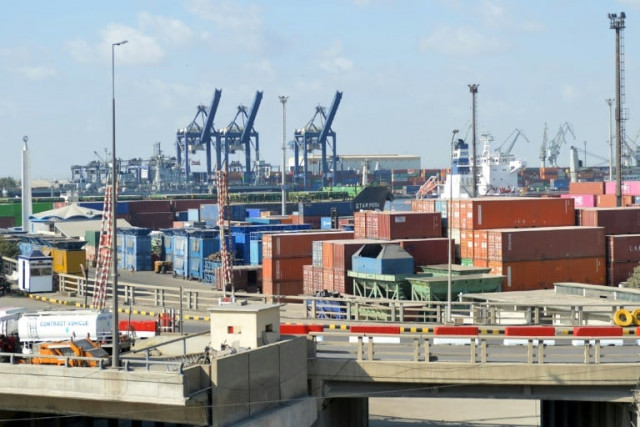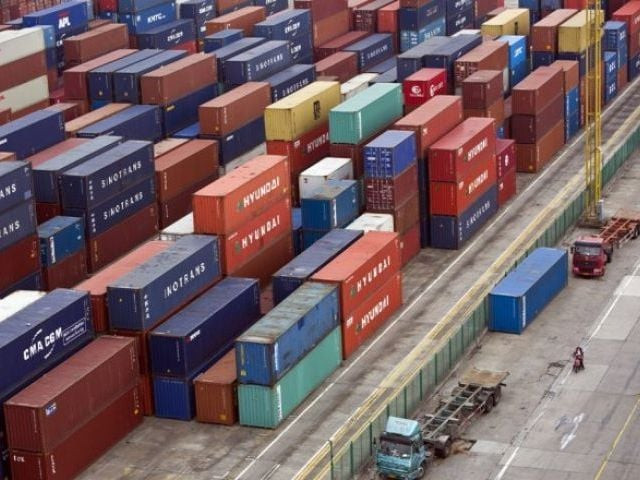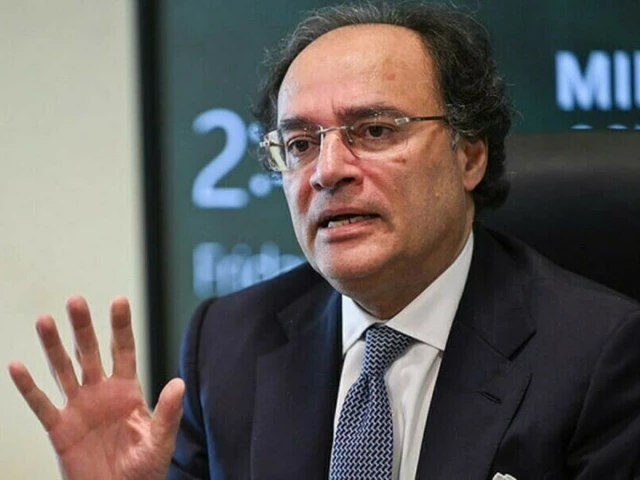Business
Karachi port deepens for bigger ships | The Express Tribune

KARACHI:
Karachi Gateway Terminal Limited (KGTL), a joint venture of AD Ports Group and Kaheel Terminals, a UAE-based company, has launched an ambitious dredging programme at the East Wharf of the Port of Karachi. The initiative will deepen berths and navigation channels at KGTL, enabling the terminal to accommodate post-panamax vessels with a capacity of over 13,000 TEUs.
Simultaneously, KGTL’s sister venture, Karachi Gateway Terminal Multipurpose Limited (KGTML), will enhance its bulk handling capability, allowing the accommodation of vessels up to 120,000 tonnes compared to the current 60,000 tonnes.
For Pakistan’s exporters and importers, these upgrades will translate directly into tangible gains. Post-panamax vessels are larger ships that bring economies of scale, reducing per-unit freight costs and optimising foreign exchange expenditure on shipping. In turn, more competitive pricing will strengthen export volumes, particularly for industries such as cement, rice, and fertilisers.
The dredging project, scheduled for completion in early 2026, is also expected to improve operational efficiency. The turnaround time for a 60,000-tonne grain vessel is projected to drop from 12 days to just three, cutting port stays by days and boosting throughput significantly.
The Port of Karachi already handles approximately 60% of the nation’s cargo, underscoring its central role in Pakistan’s import-export activity.
By enhancing its capacity on major shipping lanes, Pakistan can position itself more effectively as a gateway for the “Middle Corridor,” linking Central Asia with global markets.
However, experts caution that infrastructure upgrades alone will not guarantee efficiency unless operational bottlenecks are addressed. Karachi Port has long struggled with congestion, ageing equipment, and fragmented customs procedures. Unless improvements extend beyond the quayside to hinterland connectivity, trucking networks, and rail freight, much of the benefit from dredging could be diluted.
By deepening berths, the port will be better integrated into global shipping routes, strengthening Pakistan’s case as a South Asian maritime hub. Yet, regional competition is intensifying. Ports in India, Sri Lanka, and the Middle East are rapidly modernising, offering digitalised customs clearance, bonded logistics parks, and intermodal connectivity.
For Karachi to keep pace, parallel investments in automation, digital tracking, and customs reforms will be essential. Without these measures, even with deeper berths, shipping lines may favour alternative regional hubs that promise smoother operations and lower transaction costs.
The dredging project is fully funded by AD Ports Group under long-term concessions, 50 years for container handling and 25 years for bulk cargo. The investment signals confidence in Pakistan’s maritime future at a time when foreign direct investment remains volatile. Yet, Pakistan’s broader economic fragility could still cast shadows. Currency fluctuations, high energy costs, and political uncertainty risk undermining the competitiveness the project seeks to bolster.
Large-scale dredging projects also raise environmental and urban planning challenges. Sediment disposal, marine ecosystem disruption, and coastal erosion are concerns requiring careful management.
Business
Novo Nordisk cuts sales and profits guidance amid obesity drug competition

The drugmaker behind Ozempic and Wegovy has cut its sales and profit targets in the face of intense competition from other weight-loss and diabetes treatments.
Novo Nordisk warned over weaker-than-expected profits amid the recent growth of US rival Eli Lilly’s Mounjaro and Zepbound injection treatments.
The boss of the Danish pharmaceutical firm linked its reduced guidance to the market for weight-loss treatments being “more competitive than ever”.
Mike Doustdar, chief executive of Novo Nordisk, said: “While we delivered robust sales growth in the first nine months of 2025, the lower growth expectations for our GLP-1 treatments, for diabetes and obesity, have led to a narrowing of our guidance.”
The firm said sales are set to rise by up to 11% this year. It had previously guided towards growth of up to 14%.
It also reported that operating profits will rise by up to 7% this year, pulling down its previous guidance of up to 10%.
It came as the business reported that sales in its diabetes and obesity care division grew by 12% in Danish kroner, or 15% at constant currency rates, over the first nine months of 2025.
This included a stronger performance across obesity, with 7% growth in the diabetes-focused part of the division, which includes Ozempic.
Meanwhile, operating profits grew by 5%, or 10% at constant currency rates, for the year so far.
It said this included a nine billion kroner (£6.7 billion) impact from one of restructuring costs.
This came after the company launched a major overhaul in September, which included plans to cut around 9,000 jobs globally.
Mr Doustdar added: “Our company-wide transformation has already driven operational efficiencies, and we have a renewed focus that can deliver a range of potential treatment options that will serve millions more patients, mainly in obesity.
“We aim to accelerate on all fronts to be able to compete better in dynamic and increasingly competitive markets.”
Business
Britain sliding ‘into economic crisis’ over £85bn sickness bill, ex-John Lewis boss warns

Emer MoreauBusiness reporter
 Getty Images
Getty ImagesThe number of sick and disabled people out of work is putting the UK at risk of an “economic inactivity crisis” that threatens the country’s prosperity, according to a new report.
There were 800,000 more people out of work now than in 2019 due to health conditions, costing employers £85bn a year, according to the review by former John Lewis boss Sir Charlie Mayfield.
The problem could worsen without intervention, but Sir Charlie, who will lead a taskforce aimed at helping people return to work, said this was “not inevitable”.
The move has been broadly welcomed, but some business groups said Labour’s Employment Rights Bill included some disincentives to hiring people with existing illnesses.
One in five working age people were out of work, and not seeking work, according to the report, which was commissioned by the Department for Work and Pensions but produced independently.
Without intervention, another 600,000 people could leave work due to health reasons by the end of the decade.
Sir Charlie said sickness cost employers £85bn a year through issues including lost productivity and sick pay, but it also cost the broader economy.
“Work is generally good for health and health is good for work,” he told BBC Breakfast.
He added that the rise in sickness was being driven by a “surge” in mental health issues among young people and muscular skeletal issues, aches and joint pain in older people that was leading them to leave work.
“For employers, sickness and staff turnover bring disruption, cost and lost experience,” he said. “For the country, it means weaker growth, higher welfare spending and greater pressure on the NHS.”
Illness-related inactivity costs the UK economy £212bn annually, by some estimates, or nearly 70% of income tax, through lost output, increased welfare payments and additional burdens on the NHS.
The independent Office for Budget Responsibility has forecast that the bill for health and disability benefits for working age people alone is set to rise to about £72.3bn in 2029-30.
People could be encouraged to stay in work if health is viewed as “a shared responsibility between employers, employees and health services”, he said.
Sir Charlie added his taskforce would work with GPs who say they find it difficult to judge whether or not a person is suitable to work while they are ill, but are asked to issue sick notes by patients.
The report comes as the government tries to move ahead with its Employment Rights Bill – which some businesses say will stifle growth.
The proposed new law includes a right to guaranteed hours and cracks down on zero-hour contracts without the offer of work.
Retailers understand the importance of supportive workplaces, chief executive of the British Retail Consortium Helen Dickinson said, adding that many already invest in programmes to support workers with ill health or disabilities.
However, she said the government’s goals and its policies, such as the Workers Rights Bill, were “at odds with one another”.
“While encouraging employers to invest in workforce health and provide flexibility, they risk making it more difficult,” she said.
“In its current form, the Employment Rights Bill would make it harder for retailers to continue offering as many crucial flexible roles.”
Chancellor Rachel Reeves is also aiming to guarantee paid work to young people who have been out of a job for 18 months.
Those who do not take up the offer could face being stripped of their benefits.
‘I want to find a job’
Loz Sandom has mental and physical health conditions which has made it difficult to find a job, and the last time they worked was a year ago.
“I am willing to do the work, and I want to. I want to find a job,” said the 28-year-old, who has a degree in illustration and has previously worked as a digital marketing executive.
With support from the charity Scope, Loz is looking for an employer willing to accommodate the adjustments they would need in a workplace.
Loz said that part of the challenge was employers did not realise they had “a duty to provide reasonable adjustments”.

“It’s such a shame because they’re missing out on so many fantastic disabled people that can do fabulous jobs.
“And I’m not blaming employers entirely. They need support as well,” Loz added. “There are things that can be put in place to help employers, help save people.”
Responding to the report, the government announced a major partnership with over 60 companies, many of them large employers, to “tackle the rising tide of ill-health that is pushing people out of work”.
The companies include Tesco, Google UK, Nando’s and John Lewis.
Over the next three years, they will “develop and refine workplace health approaches” which aim to “reduce sickness absence, improve return-to-work rates, and increase disability employment rate”.
The government is aiming to develop these changes into a voluntary certified standard by 2029.
Speaking to the BBC, Work and Pensions Secretary Pat McFadden said the report was a “win-win for employees and employers because it’s aimed at keeping people with sickness issues or developing disability issues in work”.
“That’s in the interests of employers because these are good experienced staff and it’s in the interests of employees too because most people want to stay in work if they possibly can.”
The Resolution Foundation think tank’s chief executive Ruth Curtice said: “The review has accurately identified a culture of fear, a dearth of support and structural barriers to work as key challenges to overcome in turning the tide for Britain’s economic inactivity problem – which is currently trending in the wrong direction.”
The CIPD, which represents HR professionals, welcomed the government’s vision for a preventative approach to illness in the workplace.
But its chief executive Peter Cheese said: “The report’s success will depend on the extent to which these recommendations are understood by business in driving positive outcomes and backed by policy makers at a national and regional level.”
Dr Roman Raczka, president of the British Psychological Society, welcomed a shift towards “rehumanising the workplace” but noted that “not everyone will be clinically well enough to be considering a return to employment”.
“While being in employment can improve a person’s mental health and wellbeing in certain circumstances, it is vital that we should adopt a thoughtful approach to those too sick to work.
“The workplace itself can be a root cause of poor mental health.
“Those signed off with sickness, deserve timely access to safe and compassionate care, with support from psychologically informed mental health professionals.”
With additional reporting from Erica Witherington

Business
‘Benchmark for countries’: FATF hails India’s asset recovery efforts; notes ED’s role in returning defrauded funds – The Times of India

NEW DELHI: The Financial Action Task Force (FATF) acknowledged India’s efforts in recovering public assets lost to financial crimes, highlighting a money laundering case where land confiscated by the Enforcement Directorate (ED) was identified for the construction of a new airport that would serve the public.The acknowledgment comes in FATF’s latest 340-page report titled ‘Asset Recovery Guidance and Best Practices,’ cited by PTI, which documents how countries can strengthen their systems to trace, freeze, manage and return proceeds of crime. The Paris-based FATF sets global standards for combating money laundering and terrorist financing.“The report outlines practical measures for policy makers and practitioners to identify, trace, freeze, manage, confiscate and return assets derived from criminal activity…” it said. “The guidance serves as a benchmark for countries to enhance their national frameworks and align with emerging best practices,” the Enforcement Directorate (ED) said in a statement.The report references several ED investigations involving recovery and restoration of assets to victims. These include the alleged Rose Valley Ponzi scheme, a drug trafficking case where the US sought India’s assistance leading to seizure of Bitcoins worth Rs 130 crore, and coordination between the ED and Andhra Pradesh Police CID to restore Rs 6,000 crore to victims of an alleged investment fraud.Another case cited involves the alleged diversion of public funds in a Maharashtra-based cooperative bank. The ED restored benami assets worth Rs 280 crore to compensate affected account holders after auctioning the properties. According to officials, the report noted that the confiscated properties “have been identified as a site for construction of new airport, to build infrastructure in India for the benefit of society at large”.“The contribution of India and the ED to this global effort has been substantial and widely acknowledged,” the agency said, as quoted by PTI. It added that India’s legal framework under the Prevention of Money Laundering Act (PMLA), along with operational experience, shaped key aspects of the global guidance related to value-based confiscation, provisional attachment and inter-agency coordination.The ED said the inclusion of Indian case studies “underlines the credibility of India’s enforcement mechanisms and the value of its experience in shaping future global standards.”According to FATF, the guidance aims to bring “tangible” improvement in the confiscation and return of criminal assets by enforcement agencies worldwide.
-

 Tech1 week ago
Tech1 week agoOpenAI says a million ChatGPT users talk about suicide
-

 Tech1 week ago
Tech1 week agoUS Ralph Lauren partners with Microsoft for AI shopping experience
-

 Tech1 week ago
Tech1 week agoHow digital technologies can support a circular economy
-

 Sports1 week ago
Sports1 week agoBilly Bob Thornton dishes on Cowboys owner Jerry Jones’ acting prowess after ‘Landman’ cameo
-

 Tech1 week ago
Tech1 week agoAI chatbots are becoming everyday tools for mundane tasks, use data shows
-

 Fashion1 week ago
Fashion1 week agoITMF elects new board at 2025 Yogyakarta conference
-

 Tech1 week ago
Tech1 week agoHere’s How Many People May Use ChatGPT During a Mental Health Crisis Each Week
-

 Business1 week ago
Business1 week agoTransfer test: Children from Belfast low income families to be given free tuition














